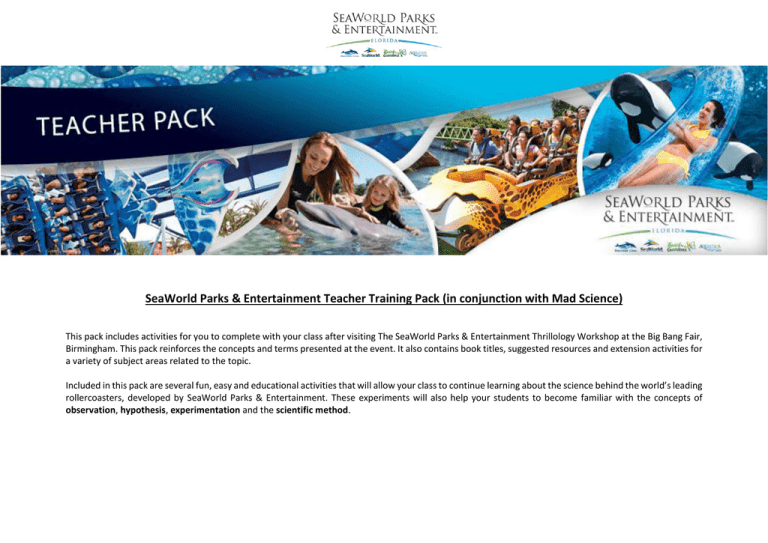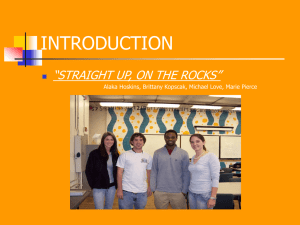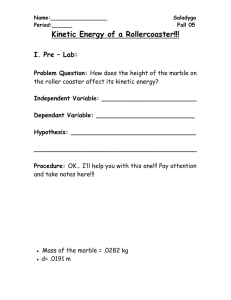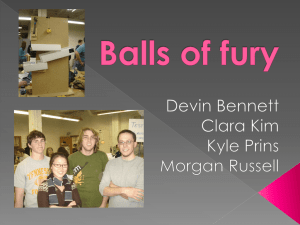
SeaWorld Parks & Entertainment Teacher Training Pack (in conjunction with Mad Science)
This pack includes activities for you to complete with your class after visiting The SeaWorld Parks & Entertainment Thrillology Workshop at the Big Bang Fair,
Birmingham. This pack reinforces the concepts and terms presented at the event. It also contains book titles, suggested resources and extension activities for
a variety of subject areas related to the topic.
Included in this pack are several fun, easy and educational activities that will allow your class to continue learning about the science behind the world’s leading
rollercoasters, developed by SeaWorld Parks & Entertainment. These experiments will also help your students to become familiar with the concepts of
observation, hypothesis, experimentation and the scientific method.
Simple Energy Experiments
The Bounce Challenge
Experiment with different types of balls to learn more about the power of energy
Materials
Metre ruler
Masking tape or chalk
Variety of balls: squash ball, tennis ball, rubber ball, steel ball or golf ball etc.
Squares of carpet
Procedure
1. Select two different types of balls and hold them up so the class can see them clearly. Ask the students to discuss which of the two balls they think
will bounce higher; you may even want to record their ideas on the board. Explain that these are their hypotheses, or best guesses, and that you are
going to conduct an experiment to see if they are correct.
2. Take the metre ruler and place it against a wall so that you can determine which of the balls bounced higher.
3. Remind the students to observe, or watch carefully, as you release the balls.
4. Release the two balls and have the students share their observations with the group. You may even ask them to record their observations in their
notebooks.
5. Repeat steps 1 - 4 with different balls to determine which bounces the highest, lowest, etc.
6. Ask the students if they think there will be any difference if the balls are bounced on carpet or different flooring. Explain that these are their
hypotheses, or best guesses, and that you are going to conduct an experiment to see if they are correct.
7. Place a piece of carpet on the floor beside the meter ruler, select two balls that are the same and bounce them on the floor.
8. Ask the students to share their observations with the group.
Explanation
Energy is something that can’t be created or destroyed and it’s everywhere around us. An object always has a certain amount of energy, but we need to know
exactly which kind of energy it has. There are many different kinds of energy. The main ones are potential energy (stored) and kinetic energy (moving).
When the ball was held in the air before it was released, it wasn’t moving, therefore it had no kinetic energy. Instead we know that it has potential energy
because if the ball is released, we know that it will fall. After the ball is released, all the potential energy gets changed to kinetic energy, and we know this
because the ball drops really fast. Another factor contributing to the ball dropping is the Earth’s gravitational pull. Earth’s
gravity is what keeps you on the ground and causes objects to fall, which in this case can be seen when the balls are released
and drop to the floor.
These scientific theories are also applied to the rides at SeaWorld Parks, for example Falcon’s Fury at Busch Gardens.
Falcon’s Fury is a drop tower which lifts riders 335 feet in the air (potential energy), once the riders have reached the top,
their carriage is then released and plunges straight down at 60mph. Kinetic energy and gravity combined make the riders
descend so quickly.
The materials and design of the balls also contribute to how high the ball bounces after it falls. If for example, you compare
a tennis ball and a golf ball, and drop them both from the same height, the tennis ball will always bounce higher than the
golf ball. This is due to the different mass of the balls. If the ball is heavier, it will have more mass, therefore this will affect
the speed that the ball will fall to the floor (kinetic energy) and therefore will inevitably reach a lower height once it has hit
the floor and bounced up again.
Swinging Buckets
Demonstrate centripetal force
Materials
One bucket or several if you wish each student to perform the experiment
Several balls, confetti or water
Note
If using water, the children or flooring may get wet when the bucket is tipped upside down
Procedure
1. Fill the bucket with your object of choice
2. Ask the students to discuss what happens to the object(s) inside the bucket when the bucket is tipped upside down. Explain that these are their
hypotheses, or best guesses, and that you are going to conduct an experiment to see if they are correct.
3. Tip the bucket upside down and ask the students to observe what happens to the object(s).
4. Now ask the students to discuss what happens to the object(s) inside the bucket when you/they spin the bucket around very fast. Explain that these
are their hypotheses, or best guesses, and that you are going to conduct an experiment to see if they are correct.
5. Ask the students to share their observations with the group
Explanation
When you or the student tips the bucket upside down, the objects fall to the ground due to the gravitational pull towards the earth. Earth’s gravity is what
keeps you on the ground and causes objects to fall, which in this case can be seen when the objects fall from the bucket. However, when you or the students
spin the bucket around quickly, you will notice the object does not fall out but instead is pushed to the side of the bucket. This is known as centripetal force.
Newtons Law of Motion states that a moving object would like to continue in a straight line at its current speed, however when the object hits a loop, this
energy is transferred in to centripetal force, which pushes the object in to the circle and in this case to the edge of the bucket.
This is the same principal used when rollercoasters go round loop the loops. When a rollercoaster car is released and starts traveling around the track (kinetic
energy), the rollercoaster car builds up a certain amount of speed, therefore when the rollercoaster car goes around a loop, centripetal force pushes the car
against the track, which means the car will continue around the loop.
Expanding Your Knowledge
Marble Run
This activity will help students understand how different types of energy work together
Materials
Empty cardboard egg box
Scissors
Tape
Marbles (all the same size; 5 would be ideal)
A bottle lid (For example, the lid from a bottle of coke)
Empty egg
pockets
Hinge
pieces
Track
Sections
Procedure
1. Steps 1 - 4 can be done either before the class begins or as a separate lesson with the students where they can construct their own ramps. Take a
standard empty egg box and cut it into the following sections as illustrated above:
a. Cut across the box so that you have two sections, both with the empty egg pockets
b. Cut the two “hinge” pieces off the lid of the box
c. Cut two long pieces from the edges of the lid to make the track section
2. Stack the two empty egg pockets on top of each other
3. Put the first track section so that it is leaning on the stacked empty egg pockets shown in the diagram.
4. Use the hinge pieces from the lid as connectors for the track so that you can set up the track for your marbles. Tape the tracks so that they stay
together.
5. Set up a chain of five marbles along the bottom of the track. You need to make sure that they stay still and are next to each other.
6. Ask the class what they think will happen once you roll the first marble down the ramp. Explain that these are their hypotheses, or best guesses and
that you are going to try an experiment to see if they are correct.
7. Remind the students to observe, or watch carefully as you perform the experiment. Roll one marble down the ramp and have the class share their
observations with the group.
8. Ask the class what they think will happen if you roll two marbles down the ramp. Again review the scientific method – hypothesis, experiment and
observation.
9. Ask the students to experiment with different numbers of rolling marbles and marbles in the chain. You can also try to space the marbles in the chain
about an inch or 2.5 cm apart. Ask the students to tell you what happens when rolling marbles collide with the chain of marbles?
Explanation
Energy is very interesting as it can be changed from one form to another, but it cannot be destroyed. The
total amount of energy that you have in a system always stays the same. Scientists call this idea, the Law of
Conservation of Energy. The rolling marble is moving, so it has the energy of motion which is called kinetic
energy. When the rolling marble hits the first marble in the chain, the last marble rolls away, this is because
the moving marble’s energy is transferred through the chain of marbles. Two moving marbles will have
twice as much energy as one marble, so they knock two marbles off the chain. A rollercoaster ride also
demonstrates how different types of energy work together, especially potential energy and kinetic energy.
When a rollercoaster car ascends, it is usually being pulled by a machine (this is when the potential energy
is built up) then once the car reaches the highest point, the car is then released. The potential energy is
transferred in to kinetic energy which contributes the car moving along the track, along with other factors
such as gravity.
Runaway Cars
Use a toy car to learn more about how energy makes things move.
Materials
The ramp created from the “Marble Run” experiment or a ramp/race track to be used with toy cars
Small toy car
Note:
Perform this experiment as a demonstration. You can also make this experiment harder for older children, by putting different materials on the ramp to
creative friction.
Procedure
1. Explain to the class that you are going to learn more about energy by conducting an experiment.
2. Set up the ramp.
3. Ask the students if they know how far the car will move once you release it from the top of the ramp. Explain that these are their hypotheses or best
guesses and that you are going to perform an experiment to see if they are correct.
4. Hold the car at the top of the ramp and remind the students to observe or watch carefully while you perform the experiment.
5. Release the car and have the students share their observations with the group.
6. Change the incline of the ramp and ask the students what they think will happen when you release the car.
7. For older children you can place different materials on to the ramp to demonstrate friction, such as pieces of carpet or sandpaper. Ask the students
to discuss what will happen to the speed of the car when moving along the different pieces of material.
8. Explain that these are their hypotheses, or best guesses and that you are going to perform an experiment to see if they are correct.
9. Hold the car at the top of the ramp and remind the students to observe or watch carefully while you perform the experiment.
10. Release the car and ask the students to share their observations with the group.
Explanation
In science, the Law of Conservation of Energy says that energy can neither be created nor destroyed. Since we can’t create it, energy
must change from one kind to another. When we lift the toy car to the top of the ramp, we give that car potential energy. Since the
ramp is on a slope, we let it go and see it roll down as the potential energy has changed into kinetic energy. When we release the
car from a higher level on the ramp, we can observe that the car will travel a farther distance along the floor. By raising the car to a
higher level, we are giving it more potential energy, and therefore it has more energy that gets converted to kinetic energy causing
it to travel fast. For the older children, where friction has been demonstrated, this shows how the car can be slowed down using
different materials or elements. This experiment links to many of the rides at SeaWorld Orlando and Busch Gardens Tampa Bay, as
rollercoaster cars, can be slowed down by using different materials based on friction. For example, Sheikra at Busch Gardens Tampa
Bay, uses water to slow the rollercoaster car down at the end of the ride. The track at the end of the ride is partially submerged in
water, which slows the car without getting the riders wet.
Task Extensions
Magnets (Ideal for KS1 & KS2)
These facts can be used for a quiz, Fact bingo, and/or spellings.
Maths
If you completed the “Marble Run” activity, the students can measure the distances that the marbles have travelled. A further suggestion would be to
plot the distances on a graph.
Record the measurements from the “The Bounce Challenge” experiment and plot them on a graph.
Languages / English
Quiz the class on Magnets! This is ideal for KS1 and KS. Here are some facts which can be used 1. Most of the magnets you see around you are man-made. Since they weren't originally magnetic, they lose their magnetic characteristics over time.
Dropping them, for example, weakens their magnetism, as does heating them, or hammering on them, etc.
2. Air-core magnets are created by a current flowing through a wire. That current produces the magnetic field.
3. Electromagnets are different because they have a ferromagnetic material (usually iron or steel) located inside of the coils of wire. The core isn't air,
it is something that aids in producing magnetic effects, so electromagnets are typically stronger than a comparable air-core magnet.
4. The Earth is a giant magnet. It’s magnetic field is like a bar magnet located at it’s centre.
5. Magnets are usually made from iron or steel, but aluminium, steel-iron, copper, nickel and cobalt can also be made into powerful magnets.
6. Many scientists believe that birds are able to find their way home by using the Earth's magnetic field to guide them on long distance flights.
7. Some vets use magnets to pick up pieces of wire or other metal from inside the stomachs of large farm animals.
8. Today, new trains use magnets to lift them off the ground so that they float. Floating reduces friction and allows the train to run more efficiently.
9. If you attach a bar magnet to a piece of wood and float it in a bowl of water, it will slowly turn and the magnet’s north pole will point towards
the Earth’s North Pole.
10. A compass has a tiny bar magnet in it and works the same way as a bar magnet in water, helping explorers find their way.
Discuss with the class how energy can be converted from one form to another – for example the energy that you put into a rubber band when you stretch
it, and the energy it is converted in to when it is released. A further suggestion would be to ask the students to write a poem regarding the process.
Review the concepts of kinetic energy, the energy of motion, and have the students write advertisements all about the benefits of kinetic energy.
For older children, you could ask them to focus on a particular rollercoaster at SeaWorld Parks and ask them to write a review on how this particular ride
works, highlighting the scientific theories behind each point.
A further suggestion for advanced older children would be to write a covering letter applying to for the job of ‘Chief Rollercoaster Engineer at SeaWorld
Parks & Entertainment’, highlighting their knowledge of rollercoaster science and fictional work experience.
Art
Following the same method as the “Measuring Energy” experiment, you can ask the students to create art from science using a piece of plasticene and
assorted sizes of marbles. Have them drop the marbles from different heights to see the different indentations that are made. Let the plasticene dry to
create their own modern art piece.
This is a messy activity but a lot of fun and an excellent illustration of kinetic energy. Give each child a small block of wood, a plastic spoon and two elastic
bands. Attach the handle of the spoon to the block of wood with the elastics to create a mini-catapult. To start, tape a piece of paper to the wall
(preferably outside) and ensure that there is newspaper to cover the floor where the children are working. Place some thick finger paint in the spoons
and ask the students to tap the spoon and release so that the paint flies on to the paper. They will create their own abstract masterpieces.
Social Studies
Ask students to research the different energy sources that exist.
Challenge the students to prepare projects about the types of energy that have been used to power transportation machines (such as cars, trains planes)
throughout history. You may even want them to present the projects to the group and plot each invention on a class timeline.
Supporting reading materials
Title: Energy: Simple Experiments for Young Scientists
Author: Larry White
Publisher: Millbrook Press Trade
ISBN#: 0761300880
Description: This book includes experiments that test sound, chemical, electrical, atomic, and mechanical energy.
Title: Energy and Power
Author: Rosie Harlow
Publisher: Kingfisher Books
ISBN#: 1856976092
Description: This book contains activities, experiments and general information on energy. It will help children to learn more about how energy works and the concepts behind
it.
Key Vocabulary
Conservation: The law of conservation of energy states that energy cannot be created or destroyed, it can only be changed from one form to another.
Energy: Ability to do work.
Hypothesis: Technically, a hypothesis is a tentative explanation that accounts for a set of facts and can be tested by further investigation; a theory. Put simply, it is a
scientist’s “educated guess” and a student’s best guess. The scientists would then perform experiments to determine if the guess was correct.
Kinetic energy: Energy of motion or of a moving object.
Mass: How much matter an object contains.
Matter: Anything that has mass and takes up space.
Momentum: Strength of an object’s motion. That strength depends upon the object’s mass and speed.
Nuclear energy: The result of a chain reaction of atoms splitting apart.
Observation: The act of noting and recording something.
Potential energy: Stored energy which can be converted or changed into kinetic energy. It is the stored energy that is available to do work.
Look at SeaWorld Orlando’s new ride Mako, which will be
the tallest, longest and fastest rollercoaster in Orlando
when it opens in Summer 2016. The ride measures 200ft
high at its tallest points, travels at speeds up to 73mph and
has almost a mile of steel track.
Tasks:
Mark on the sheet where the rollercoaster car has
the most potential energy
Mark where this transfers into kinetic energy
Q: What would happen if the first drop tower is
lower than the following peak?
A: ______________________________________
Mad Science sparks imaginative learning with inquiry-based science for children. Ask us about other programs that meet
regional curriculum requirements www.madscience.org/westmidlands © Written by Jasmine Hanlon. 2016 Mad Science.
SeaWorld Parks & Entertainment brings together so many thrilling elements of wonder. Individually these are the world-famous
SeaWorld® Orlando, the tropical oasis Discovery Cove® Orlando, the unequalled splashiness of Aquatica, SeaWorld’s Waterpark®
and the wild lands of Busch Gardens® Tampa Bay! © All references to SeaWorld Parks & Entertainment, Inc. All Rights Reserved 2016.



